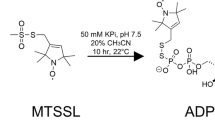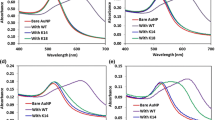Abstract
Nitroxide spin labelling is exploited in electron paramagnetic resonance (EPR) spectroscopy to study biological interactions and analysis of conformational changes in protein structures. In our study, recombinant human histone H1.3 was modified by 3-carboxy-proxyl using carbodiimide/N-hydroxysuccinimide coupling. Resulting conjugate of histone H1.3 with the spin label preserved its DNA binding capacity and formed complexes with plasmid DNA. The changes in EPR signal of the spin label were revealed upon conjugate interaction with plasmid DNA. Our preliminary data show the possibility of DNA sensing with nitroxide spin labelled histone H1.3 by EPR spectroscopy.


Similar content being viewed by others
References
Gertz, I., Likhtenshtein, G., Yamauchi, J., Nakatsuji, S., Smirnov, A., Tamura, R. (2008). Nitroxides: applications in chemistry, biomedicine, and materials science. Weinheim: WILEY-VCH Verlag GmbH & Co. KGaA.
Gafurov, M., Lyubenova, S., Denysenkov, V., et al. (2010). EPR characterization of a rigid bis-TEMPO–bis-ketal for dynamic nuclear polarization. Applied Magnetic Resonance, 37, 505–514.
Gafurov, M. (2013). TEMPOL as a polarizing agent for dynamic nuclear polarization. Magn Reson Solids, 15, 13103–13111.
Butterfield, D. A., Chesnut, D. B., Appel, S. H., Roses, A. D. (1976). Spin label study of erythrocyte membrane fluidity in myotonic and Duchenne muscular dystrophy and congenital myotonia. Nature, 263, 159–161.
Smith, I. C., & Yamane, T. (1967). Spin-labeled nucleic acids. Proceedings of the National Academy of Sciences of the United States of America, 58, 884–887.
Stone, T. J., Buckman, T., Nordio, P. L., McConnell, H. M. (1965). Spin-labeled biomolecules. Proceedings of the National Academy of Sciences of the United States of America, 54, 1010–1017.
Archer, S. J., Ellena, J. F., Cafiso, D. S. (1991). Dynamics and aggregation of the peptide ion channel alamethicin. Measurements using spin-labeled peptides. Biophysical Journal, 60, 389–398.
Rabenstein, M. D., & Shin, Y. K. (1995). Determination of the distance between two spin labels attached to a macromolecule. Proceedings of the National Academy of Sciences of the United States of America, 92, 8239–8243.
Medrzycki, M., Zhang, Y., Zhang, W., et al. (2014). Histone h1.3 suppresses h19 noncoding RNA expression and cell growth of ovarian cancer cells. Cancer Research, 74, 6463–6473.
Gross, P., Jornvall, H., Thiry, M., et al. (2008). Bis-met histone. Patent US, 20110034370, A1.
Solovyeva, V. V., Rizvanov, A. A. (2014). Application of recombinant histone protein H1.3 for inhibition of adenoviral infection. Genes and cells, IX, 125–130.
Rizvanov, A. A., Solovyova, V. V. (2014). Application of the histone protein as an inhibitor of adenoviral transduction. Patent Russian Federation, 2555553.
Solovyeva, V. V., Kudryashova, N. V., Rizvanov, A. A. (2011). The transfer of the recombinant nucleic acids into the cells (transfection) using histones and other nuclear proteins. Cellular Transplantation and Tissue Engineering, 6, 29–40.
Solovyeva, V. V., Isaev, A. A., Genkin, D. D., Rizvanov, A. A. (2012). Influence of recombinant histone H1.3 on the efficiency of lentiviral transduction of human cells in vitro. Cellular Transplantation and Tissue Engineering, 7, 151–154.
Shaposhnikov, M. N., Solovyeva, D. O., Zaitsev, S.Yu., Solovyeva, V. V., Salafutdinov, I. I., Rizvanov, A. A. (2014). Intracellular localization analysis of a conjugate of recombinant histone H1.3 with photoactivated fluorescent dye. Genes and cells, IX, 289–294.
Solovyeva, V. V. (2014). Application of recombinant histone protein H1.3 for viral and non-viral transfection of nucleic acids in cell culture. Ph.D. Thesis, Kazan Federal University (in Russian).
Acknowledgments
The work is performed according to the Russian Government Program of Competitive Growth of Kazan Federal University and subsidy allocated to Kazan Federal University for the state assignment in the sphere of scientific activities. Some of the experiments were conducted using the equipment of Interdisciplinary Center for Collective Use of Kazan Federal University supported by the Ministry of Education of Russia (ID RFMEFI59414X0003) and Pharmaceutical Research and Education Center, Kazan (Volga Region) Federal University, Kazan, Russia. A. Rodionov and M. Gafurov devote this work to Dr. Igor N. Kurkin on the occasion of his 75th anniversary.
Author information
Authors and Affiliations
Corresponding author
Ethics declarations
Conflict of Interest
The authors declare that they have no conflict of interest.
Rights and permissions
About this article
Cite this article
Chasov, V., Rodionov, A., Gafurov, M. et al. EPR Detection of DNA Interaction with 3-Carboxy-proxyl-Labelled Recombinant Human Histone H1.3. BioNanoSci. 7, 109–111 (2017). https://doi.org/10.1007/s12668-016-0294-x
Published:
Issue Date:
DOI: https://doi.org/10.1007/s12668-016-0294-x




